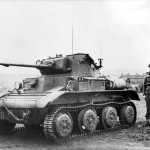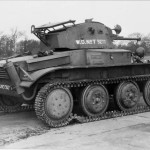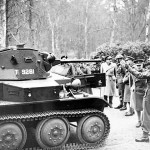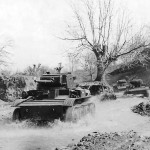Light tank Mk VII Tetrarch Mk I with Little John adaptor
Tetrarch Tank on Hamilcar Glider
Light tank Mk VII Tetrarch T9277 rear
Gen Sir Alan Brooke inspecting a Tetrarch at the Army Staff College 6 January 1941
Soviet Mk VII Tetrarch Tanks, (Виккерс VII)
Light Tank Mk VII (A17) “Tetrarch”
History
Following the Light Tank Mk VI, Vickers designed a larger type of light tank in 1937 capable of mounting a 15mm Besa gun in place of the machine guns which were mounted in previous Vickers light tanks. For the Mk VII Vickers adopted a novel type of suspension incorporating large road wheels. As with some earlier Vickers designs, however, steering was achieved by flexing the tracks. The Mk VII was offered to the War Office in 1938 (unofficially as the “Purdah”) and the vehicle, designated A17, was tested for possible future adoption as a “light cruiser” tank, since War Office light tank requirements were already being met by Mk VI production. An order for 120 vehicles was placed at the end of 1938, when war seemed inevitable, and Vickers were asked to transfer production to Metropolitan-Cammell to be free to do other work.
Unlike earlier vehicles in this class, tank used a modified Christie suspension in which the front wheels could be steered so as to bend the track for sentle turns. This method overcame the problem of loss of power found with steering a vehicle by skidding the tracks on the ground. If a tighter manoeuvre was necessary, the controls automatically braked one track to allow the tank to make a conventional skid turn. The suspension was pneumatic shock absorbers on each of the four road wheels. It was necessary to maintain the correct pressure with a foot-pump.
The Tetrach was saved by the establishment of airborne forces, who adopted it as their airportable armour delivered by the GAL Hamilcar glider, an aircraft that had been specifically designed to carry it. Many remained in service until 1949, when gliders were abandoned by British airborne forces. Carried by glider, the Tetrach saw action in Normandy as part of the Airborne Reconnaissance Regiment of the 6th Airborne Division. Their numbers were too small to have any significant impact on the operation. A small number of tanks were also sent to the Soviet Union during World War II. but were not popular with their Russian crews. The Tetrach was used as the test bed for a close-support tank armed with a 76.2mm (3 in) howitzer in place of its 2pdr gun, and a few tanks were fitted with Littlejohn adapters on the 2pdrs to increase muzzle velocity. In flotation trials, one Tetrach was fitted with Straussler Duplex Drive (DD) writh a swimming/flotation screen and a propeller driven off the engine. It was tested in Brent Reservoir in June 1941 and the DD system was eventually fitted to M4 Sherman tanks for D- Day.
Variants:
Tetrarch I CS: some vehicles were converted for the close support role, with 76,2 mm (3 inch) howitzer.
Tetrarch DD: 1 tank was fitted and tested with a propeller drive and canvas collapsible flotation screens.
Tetrarch with Littlejohn adaptor: fitted to increase muzzle velocity.
Bibliography:
Light Tank Mk. VII Tetrarch – Peter Chamberlain, Chris Ellis, Armour in Profile Number 11
British and American Tanks of World War Two: The Complete Illustrated History of British, American and Commonwealth Tanks, 1939-45 – Peter Chamberlain, Chris Ellis
The Great Tank Scandal: British Armour in the Second World War Part 1 – David Fletcher




